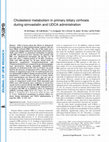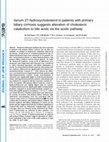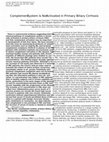Papers by Andrea Crosignani
Gut, 1996
The metabolism of tauroursodeoxycholic acid orally administered and its effects on the bile acid ... more The metabolism of tauroursodeoxycholic acid orally administered and its effects on the bile acid pool of patients with asymptomatic/mildly symptomatic primary biliary cirrhosis is described. Patients were randomly assigned 500, 1000, or 1500 mg/day of tauroursodeoxycholate for six months. Biliary and serum bile acids were measured before and during treatment by gas chromatography-mass spectrometry and by high performance liquid chromatography.

Journal of lipid research, 2001
Little is known about the effects of cholesterol-lowering agents in hypercholesterolemic patients... more Little is known about the effects of cholesterol-lowering agents in hypercholesterolemic patients with primary biliary cirrhosis (PBC). The aim of this study was to compare the changes induced by simvastatin and ursodeoxycholic acid (UDCA) on cholesterol metabolism in patients with PBC and preserved liver function. Six patients with PBC were administered simvastatin (40 mg/day) for 30 days and, after a washout period of 30 days, ursodeoxycholic acid (600 mg/day) for 30 days. Serum levels of lathosterol, campesterol, 7 alpha-hydroxycholesterol, and 27-hydroxycholesterol were measured by gas chromatography-mass spectrometry. During simvastatin administration, reduction of cholesterol levels (34% in 30 days) was paralleled by the decrease of lathosterol (55%), whereas concentrations of campesterol and of the two hydroxysterols were not substantially modified. During ursodeoxycholic acid administration, a trend toward a decrease of serum cholesterol concentrations was observed after onl...

Journal of lipid research, 1998
Reduced cholesterol synthesis has been reported in patients with primary biliary cirrhosis but no... more Reduced cholesterol synthesis has been reported in patients with primary biliary cirrhosis but no data are available on changes in cholesterol catabolism induced by the disease. Serum levels of 7alpha-hydroxycholesterol and 27-hydroxycholesterol have been measured in 25 patients (either normocholesterolemic or hypercholesterolemic) with primary biliary cirrhosis and in control subjects. To evaluate cholesterol synthesis, serum levels of lathosterol were measured, and campesterol and sitosterol were considered to reflect intestinal absorption and biliary elimination of sterols. In normocholesterolemic patients with primary biliary cirrhosis, lathosterol was significantly lower than in normocholesterolemic controls (P < 0.05) whereas no difference was found between hypercholesterolemic patients and hypercholesterolemic controls. Serum concentrations of sitosterol were significantly higher in both normocholesterolemic and hypercholesterolemic patients with primary biliary cirrhosis ...

Clinical immunology and immunopathology, 1998
There is controversial evidence suggesting that the classical pathway of complement system is chr... more There is controversial evidence suggesting that the classical pathway of complement system is chronically activated in primary biliary cirrhosis (PBC) and that complement activation may be important in development of bile duct injury. We have reevaluated this issue by measuring by-products of complement activation such as C4a, C3a, Bb, and terminal complement complexes (SC5b-9) in plasma of 44 PBC patients with sensitive methods not previously used to detect complement activation in this disease. Age-matched healthy women and patients with chronic hepatitis of different etiology were studied as controls. We found that PBC patients have normal C4a concentrations. This finding argues strongly against chronic classical pathway activation. Although a minor increase of C3a levels was observed in a minority of PBC patients, the C3a/C3 ratio, an index used to evaluate the extent of native protein conversion, was remarkably similar in all groups. Potentially lytic terminal complement comple...
The American Journal of Gastroenterology, 2009
The identifi cation of prognostic factors associated with mortality is crucial in any clinical se... more The identifi cation of prognostic factors associated with mortality is crucial in any clinical setting.

Antiviral research, 2015
Interferon Lambda-3 (IFN-λ3) gene polymorphism is associated with spontaneous clearance of hepati... more Interferon Lambda-3 (IFN-λ3) gene polymorphism is associated with spontaneous clearance of hepatitis C virus (HCV) and response to IFN-based therapy (IFN). However, very few data are available about its value in predicting sustained virologic response (SVR) in patients with cirrhosis, and whether IFN-λ3 genotype influences liver disease progression remains unclear. We determined IFN-λ3 genotype by PCR in a cohort of patients with compensated HCV-related cirrhosis, enrolled between 1989 and 1992. Person-years follow-up was calculated for each individual from the date of enrolment to the development of first episode of decompensation, HCC, liver transplant, death or end of follow-up. The follow-up of patients who achieved SVR was censored at the time of IFN initiation. Kaplan-Meier curves and Cox regression analyses were used to assess the association between IFN-λ3 genotype and clinical outcome. IFN-λ3 was determined in 264 patients (52% males, mean age 57±8years, 67% HCV genotype (G...

International Journal of Microcirculation, 1995
Experimental and clinical observation suggest that patients with primary biliary cirrhosis (PBC) ... more Experimental and clinical observation suggest that patients with primary biliary cirrhosis (PBC) have endothelial dysfunction. Postischemic digital blood flow, nailfold capillaroscopy, von Willebrand factor (vWf) and tissue-type plasminogen activator (t-PA) plasma levels were examined in 59 PBC patients. Forty-six subjects (15 with liver diseases other than PBC, 11 hypercholesterolemics, 20 healthy subjects) served as controls. PBC versus healthy controls (209.8 +/- 1.4% and 16.54 +/- 1.44 ng/ml vs. 120.2 +/- 1.4% and 9.91 +/- 1.49 ng/ml; p&amp;amp;lt;0.001) and related to bilirubin (r = 0.38, p&amp;amp;lt;0.02; r = 0.47, p&amp;amp;lt;0.0005, respectively). vWf was also increased in other liver diseases (249.9 +/- 1.7%; p&amp;amp;lt;0.001) and related to bilirubin (r = 0.59, p&amp;amp;lt;0.05). Postischemic finger blood flow negatively correlated with vWf(p&amp;amp;lt;0.05 or less). Our data indicate that PBC patients have microvascular disease. Whether vessels other than those of the fingers were involved remained unclear. vWf and t-PA might reflect a dysfunction of teh hepatic vascular endothelium.
The Journal of Pediatrics, 1990

Journal of Medical Virology, 1998
Whether sustained biochemical response and absence of serum HCV RNA in the 6-12 months following ... more Whether sustained biochemical response and absence of serum HCV RNA in the 6-12 months following suspension of interferon-alpha (IFN-alpha) therapy reflect definitive viral clearance in patients with chronic hepatitis C virus (HCV) infection is controversial. To obtain more information on this topic, HCV RNA was sought in both liver and serum samples of 25 long-term responders who were followed for a median period of 39 months (range 21-79) after discontinuation of IFN-alpha. Liver biopsy was undertaken before and 6 to 12 months after IFN-alpha withdrawal. Liver and serum HCV RNA were tested by a nested polymerase chain reaction. Twenty-two patients (88%) tested negative for both liver and serum HCV RNA, two patients had detectable HCV RNA in both liver and serum, and one patient showed persistent HCV RNA only in the liver. Post-treatment liver histology improved markedly in all patients, including those with viral persistence. During further follow-up, biochemical remission was maintained in all patients except one in whom both serum and liver specimens remained HCV RNA positive. The data indicate that the large majority of long-term responders test negative for HCV RNA in the liver, which suggests definitive eradication of HCV RNA infection.
Journal of Medical Case Reports, 2010
Introduction: A combination therapy of angiotensin-converting enzyme inhibitors and angiotensin I... more Introduction: A combination therapy of angiotensin-converting enzyme inhibitors and angiotensin II receptor blockers has been used to control proteinuria, following initial demonstration of its efficacy. However, recently concerns about the safety of this therapy have emerged, prompting several authors to urge for caution in its use. In the following case report, we describe the occurrence of a serious and unexpected adverse drug reaction after administration of a combination of angiotensin-converting enzyme inhibitors and angiotensin II receptor blockers to a patient with nephrotic syndrome and liver cirrhosis with severe portal hypertension.
Journal of Hepatology, 2008
Journal of Hepatology, 2004
Background/Aims: Estrogen receptors (ER) in cholangiocytes of primary biliary cirrhosis (PBC) pat... more Background/Aims: Estrogen receptors (ER) in cholangiocytes of primary biliary cirrhosis (PBC) patients and their relationship with cell proliferation and death were evaluated.

Journal of Hepatology, 2003
Primary biliary cirrhosis (PBC) is an autoimmune cholestatic liver disease of unknown etiology wi... more Primary biliary cirrhosis (PBC) is an autoimmune cholestatic liver disease of unknown etiology with a highly variable progression rate and prevalence among different geographical areas. Data concerning human leukocyte antigen (HLA) polymorphisms in PBC come from a limited number of geographical areas, from which the association with the HLA-DRB1*08 allele has been consistently reported. To investigate whether HLA polymorphisms contribute toward disease susceptibility, we compared 186 well-defined Italian PBC patients with 558 healthy subjects matched by age, gender and geographical area (Northern, Central and Southern Italy). Patients and controls were HLA typed at low resolution by PCR-sequence specific oligonucleotides for the loci A and B; HLA-DRB1 alleles were typed by reverse line blot assay of PCR-amplified DNA. HLA-DRB1*11 was associated with a markedly reduced risk of developing PBC (OR: 0.3; 95% CI: 0.2-0.5). No association was found with HLA-DRB1*08. The B*15 (2.5; 1.3-4.6), B*41 (12.0; 2.7-72.1), B*55 (2.9; 1.1-7.5) and B*58 alleles (6.8; 1.1-46.3) were more frequent in PBC. The frequency of HLA polymorphisms was similar in PBC patients with progressive or non-progressive disease, and in those with or without anti-mitochondrial antibodies. Our data on a large series of Italian patients suggest that PBC may have a peculiar genetic background in the Mediterranean area.

Journal of Hepatology, 2003
The best treatment for chronic hepatitis C patients who do not respond to interferon is still unk... more The best treatment for chronic hepatitis C patients who do not respond to interferon is still unknown. Reported rates of response to treatment vary as the result of heterogeneous definitions of non-responders and small study size. One hundred nineteen hepatitis C virus (HCV) RNA-positive non-responders to high-dose interferon monotherapy received alpha-interferon, 5 MU tiw plus oral ribavirin, 1000-1200 mg/day for 48 weeks (Group A, n=74) or alpha-interferon, 5 MU daily for 4 weeks, followed by 5 MU tiw plus oral ribavirin, 1000-1200 mg/day for 44 weeks (Group B, n=45) according to the Institution where they were followed. Persistently normal alanine aminotransferase and negative HCV RNA up to 72 weeks from treatment onset defined a sustained response. Eighteen patients discontinued treatment (13 developed anemia, two mucositis, one granulocytopenia; two were dropouts), none for serious adverse events. There were 24 (20%) sustained responders, with similar final response rates in Groups A and B. Sustained response was more frequent in patients aged &amp;amp;amp;amp;amp;amp;amp;amp;amp;amp;amp;amp;amp;amp;amp;amp;amp;amp;amp;amp;amp;amp;amp;amp;amp;amp;amp;amp;amp;amp;amp;amp;amp;amp;lt;/=40 years (36% vs. 13%; P=0.006) and in those with non-1 genotype (44% vs. 14%; P=0.002). Among genotype 1 patients, the younger ones showed higher response rates (32% vs. 7%; P=0.005). Compared with patients harboring non-1 genotypes, the odds ratio of being a non-responder was 1.68 (confidence interval (CI): 0.53-5.37; P=0.381) in younger genotype 1 patients and 9.53 (CI: 2.84-32; P&amp;amp;amp;amp;amp;amp;amp;amp;amp;amp;amp;amp;amp;amp;amp;amp;amp;amp;amp;amp;amp;amp;amp;amp;amp;amp;amp;amp;amp;amp;amp;amp;amp;amp;lt;0.001) in older genotype 1 patients. Chronic hepatitis C patients who are non-responders to interferon monotherapy and infected by non-1 genotypes should undergo re-treatment with combination therapy. Treatment should be extended to younger genotype 1 patients who are more susceptible to liver disease worsening because of longer life expectancy and have a higher probability of being long lasting responders than their older counterparts.

Journal of Hepatology, 1993
Ursodeoxycholic acid (UDCA or ursodiol) administration has been associated with a reduction of se... more Ursodeoxycholic acid (UDCA or ursodiol) administration has been associated with a reduction of serum liver enzymes in patients with chronic liver disease and with improvement of liver histology in patients with primary biliary cirrhosis. To establish the potential therapeutic efficacy of ursodiol in chronic hepatitis, serum biochemistry and liver histology were investigated in a multicenter, double-blind placebo controlled clinical trial. Sixty patients with non-cholestatic chronic active (mild or severe) hepatitis, mainly of viral (virus C) etiology and almost completely asymptomatic, were enrolled in 3 centers: 29 were assigned to receive placebo and 31 UDCA (600 mg/day) for 1 year. Demographic, biochemical, virological and histological features were balanced between the 2 groups at the entrance into the study. Fifty-six patients (34 males, 22 females; 19 with cirrhosis; 5 HBsAg-positive; 45 anti-HCV positive) were included in the final analysis. Compliance was checked by measuring UDCA levels at the 3 follow-up visits (3, 6 and 12 months). Liver biopsy was performed at the beginning and at the end of treatment and was evaluated blindly by our pathologist (F.C.). Alanine aminotransferase (ALT), aspartate aminotransferase (AST) and gammaglutamyltransferase (GGT) levels were significantly reduced by 25% from baseline values during treatment with ursodiol but not with placebo. The efficacy of UDCA in lowering serum AST and ALT was more pronounced in the presence of cirrhosis. The semiquantitative liver histological score used remained substantially unchanged after treatment and no differences between placebo and UDCA were found for portal or periportal necrosis or inflammation, intralobular degeneration, cholestasis or fibrosis.(ABSTRACT TRUNCATED AT 250 WORDS)

Journal of Hepatology, 2001
Assessment of chronic hepatitis C outcome in sustained responders to interferon requires prolonge... more Assessment of chronic hepatitis C outcome in sustained responders to interferon requires prolonged observation and close monitoring. We prospectively studied the impact of sustained response on histology and clinically relevant outcomes. The 47 sustained responders (ten with cirrhosis) from two interferon trials involving 235 chronic hepatitis C patients (81 with cirrhosis) were included. Hepatitis C virus (HCV) RNA was assessed every 6 months, liver histological changes from baseline, 6-12 and 48-72 months after treatment discontinuation. The mean follow-up was 102 +/- 19 months. HCV RNA became undetectable in 36/47 responders. Four responders, who had remained viremic, later relapsed. The histology progressively improved in non-viremic and viremic patients, with a more marked improvement in the former (P = 0.0089), normalizing in 53 vs. 0% (P = 0.0220). No patient progressed to cirrhosis. One non-viremic cirrhotic patient developed a hepatocellular carcinoma. Non-responders from the two original trials had worse histological outcomes and those with cirrhosis had a higher rate of clinically relevant events compared with cirrhotics showing a sustained biochemical response (4.5 vs. 1.2 cases/100 person-years; CI for the difference, 0.3-6.3). Most sustained, virological responders without cirrhosis normalize liver histology in the long-term and are cured of the disease. Sustained responders remaining viremic still show histological improvement, albeit to a lesser extent.
Journal of Hepatology, 1999
Journal of Hepatology, 1999
Journal of Hepatology, 2001

Uploads
Papers by Andrea Crosignani